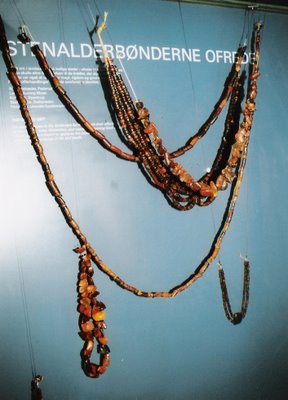
When looking for amber at the beach you might be lucky to find a lump with insect fossiles.
Amber is fossilized tree resin from a died out pine-tree from the warm period before Ice Age. It is not known, where the forest grew from where the Nordic amber comes, but probably somewhere in the Baltic area. When the ice came, it ploughed up the land, and the amber is now only known from re-placed layers. It is found in many places in Denmark's ground, but the main finding place is the western coast at Jutland, where the sea breaks down the land, while the stream eats from the sea bed, washing out the amber. It is still possible to do some good findings at this beach, but earlier there was much more amber - and most of the Danish prehistoric amber comes probably from here.
The condition of the forming of amber is that the resin ends in the sea-bed and lies there for at least 230-250 million years. First after this long oxygen-free process with press influence, in which the plant juice changes and the oil contents is reduced, the genuine amber is formed. The transitional forms between resin and genuine amber is named kopal. This material is more porous, so that flakes can be removed by a nail. The oldest amber in the world is 235-231 million years old and is found in Austria and Bavaria. Denmark's oldest amber is found at Bornholm and is 170 years old. Amber found upwashed at a sea shore is considered finer than amber digged up from the soil. When looking for amber at the beach you might be lucky and find a lump with insect-fossiles.

Amber can burn and gives thereby a fine scent. When you rub amber static electricity is generated. When the amber is used for jewelry it is often heated up and later cut and polished. It is said that amber jewelry "likes" to be used. The contact with the skin keeps the amber bright, while it gets dull by being left in a drawer.

Amber from a Stone-Age sacrifice.
Since Antiquity humans have used amber and amber jewelry as a means of payment and since then amber also had a role as a panacea against all kinds of diseases. There are many proverbs and stories about amber - one of the stories tells how amber came into existence: when the fertility goddess Freya's husband disappeared, she cried bitter tears. The tears that landed upon the ground became gold, the tears that landed in the sea became amber.

photo Skagen/Randers kulturcenter 2007/2008: grethe bachmann
No comments:
Post a Comment